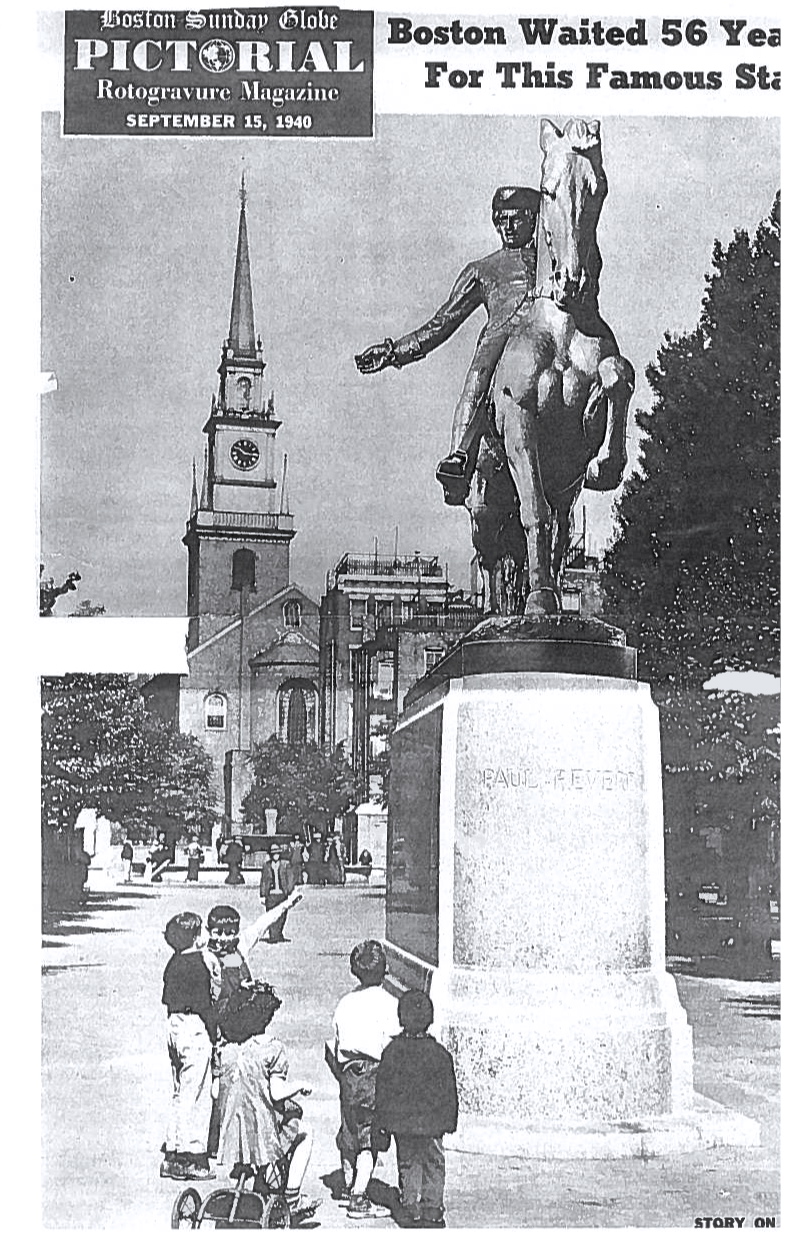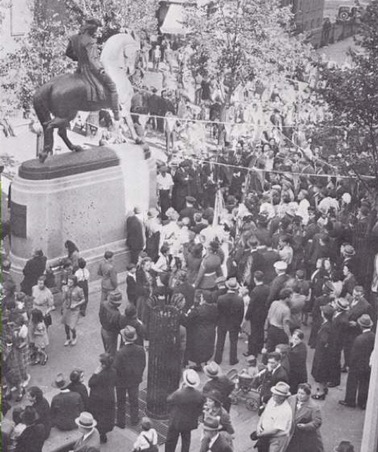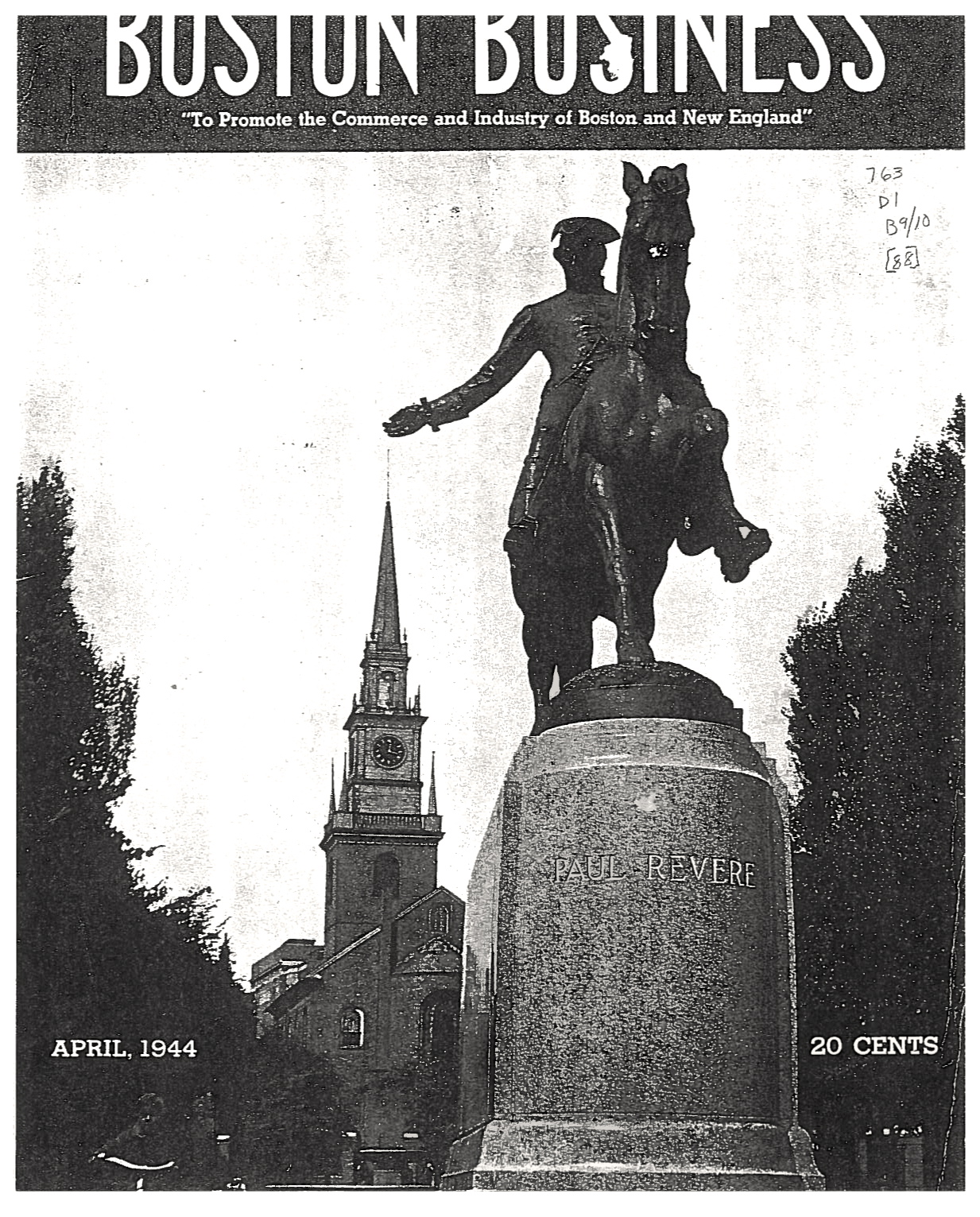In the second part of this series on the Prado (view Part I), we present historical facts and stories about the famous Paul Revere equestrian statue on the Prado – Paul Revere Mall. We went through newspaper articles, magazines, and other historical sources dating back to the early 1930’s. We’ll take you through the in’s-and-out’s of the Paul Revere statue, from the sculptor to how it ended up in the Prado.

Unveiling the Equestrian Statue of Paul Revere

Many may not know that the famed statue of Paul Revere did not arrive in the Prado until the mall was 7 years old. The Paul Revere Statue was formally revealed in a ceremony on Sunday September 22, 1940 at 2:30pm. The ceremony featured a band playing music, chorus, and a list of speakers featuring:
- Joseph F. O’Connell, manager of the White Fund, who presented the memorial to the Mayor of Boston.
- Mayor Maurice J. Tobin introduced the main address given by the honorable Henry L. Shattuck of the Boston City Council and former treasurer of Harvard University.
- Also on site for the ceremony were: local, state, and national officials including, National Commander Raymond J. Kelly of the American Legion, who happened to be in town at the time for the American Legion National Convention.
Also in attendance were representatives of historical societies, military, naval, and veteran groups. Thousands of people jammed the mall to see the unveiling. Mayor Tobin reviewed the cosmopolitan population of the North End from its early days to the present and stated: “Out of this crucible has come the most honorable government of the world.”

Sculptor Cyrus E. Dallin
Although Cyrus Dallin is widely known for the “Appeal to the Great Spirit” sculpture at the Museum of Fine Arts, many experts consider his equestrian “Paul Revere” statue to be his masterpiece.
Dallin made Paul Revere’s statue on his famous “midnight ride” showing Revere as he reins in his horse, and shouts to a farmer that the British are coming. Dallin created seven models of the Paul Revere statue before a final version was selected. Over the course of Dallin’s life, he made over 50 sculptures and 38 paintings.
Cyrus Dallin modeled the final version of the statue in clay in 1885 but failed to find a buyer until 1940 when the City of Boston cast it in bronze and installed it in the mall. Dallin attended the unveiling, 55 years after he made it. (See also this video presentation “Arrested Motion: Cyrus Dallin’s Statue of Paul Revere” by Rebecca Reynolds)
The sculptor, Cyrus Edwin Dallin was born on November 22, 1861 in Springville, Utah. He was one of 8 children, the oldest boy to Thomas Dallin, who left England and came to the United States in 1851. Dallin was raised in a small one-story cabin, his hometown was surrounded by a 10 foot high wall that was intended to protect against Indians. His lifestyle was far from glamorous, he lived mostly outdoors, barefoot, and in patched clothes. Growing up, Dallin spent his time shooting ducks, herding cows, cutting firewood, and gathered berries.
- In 1880, he moved to Boston and entered the studio of Truman H. Bartlett, a sculptor in Boston.
- 1881 Dallin moved to Quincy and worked for Sidney H. Morse, a poet, writer, and sculptor.
- 1882 he moved to Charlestown and then later moved to a small studio in Pemberton Square, Boston.
- 1885 Dallin signed a contract to make a Paul Revere statue, not knowing where it would end up.
Dallin’s Three Sculptures in Boston
1) Appeal to the Great Spirit, Museum of Fine Arts
2) Paul Revere Statue in the Prado / Paul Revere Mall
3) Anne Hutchinson, Massachusetts State House grounds
The Cyrus Dallin Art Museum is the leading center for the study and enjoyment of Dallin’s work, located at 611 Massachusetts Avenue in Arlington Center. Visit www.dallin.org for more information.
Sources:
Downes, William H. Cyrus E. Dallin, Sculptor. N.p.: New England Magazine, 1899. 196-209. Print.
Dallin, Cyrus E. SCULPTURE and Third Dimension Paintings. N.p.: Boston Art Club, 1934. 1-4. Print.
Thank you to Anne M. Pistorio for her research and guidance for this article.
Please also see these photo and video posts about the history of the Prado – Paul Revere Mall:
- Community Comes Together to Celebrate Cyrus Dallin, His Iconic Paul Revere Statue and the Prado (Photos)
- “The Pride of Later Generations: North End History Remembered in The Prado” by Alex R. Goldfeld (Video)
- “Arrested Motion: Cyrus Dallin’s Statue of Paul Revere” by Rebecca Reynolds (Video)
- “The Prado: It’s History and Future” by David A. Kubiak (Video)




Thanks for posting. Local legend has it that the statue of Paul Revere was originally supposed to face the Old North Church, but William Cardinal “Gangplank Bill” O’Connell objected to the plan because he didn’t want the parishioners of St. Stephen’s Roman Catholic Church directly opposite the Prado on Hanover Street to behold a horse’s rear end as they exited Mass. Given it was all done under the Curley administration, the Cardinal’s will easily prevailed.
This is wonderful The rich history! I have to get the book or more information All of my siblings (7 of us) have taken a picture in front of Paul Revere statue on special occasions of course dating back from 1915 when my grandmother and Mother came from Italy to live in North End and mom is still here at 105 years old